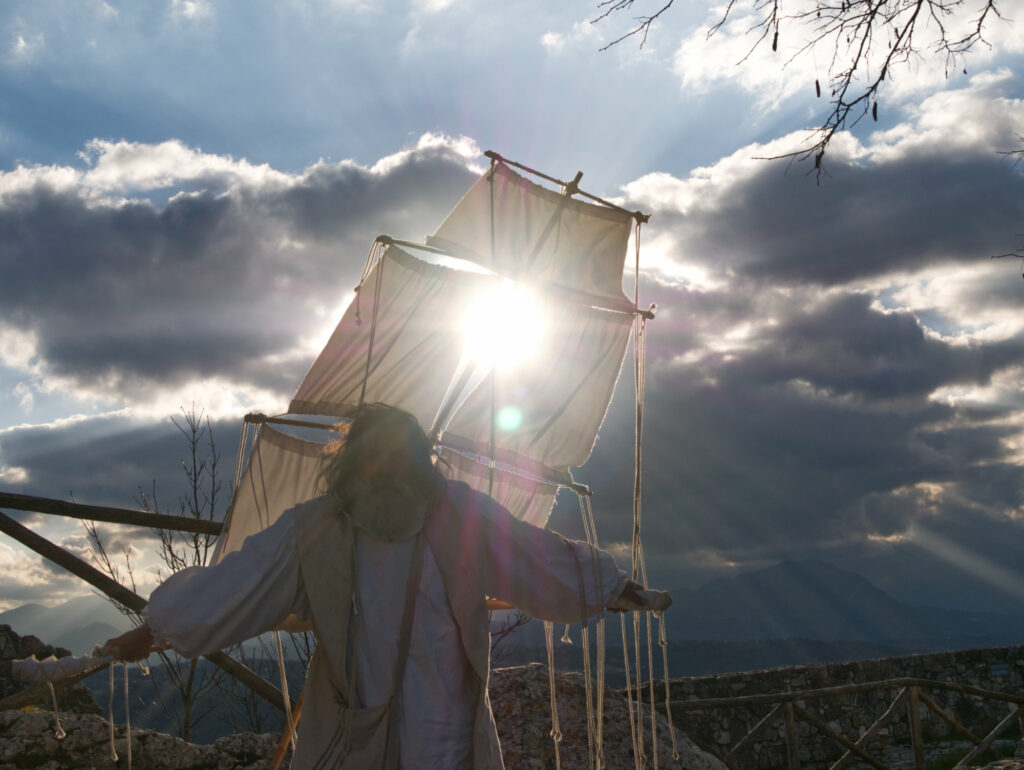Tuesday 7th March 2023
This marks our final day in Italy, and we set off towards Ariano Irpino, a midway point en route to Naples from where we shall return to Berlin.
Our first stop is Mefite, a sulphurous lake valley located near Rocca San Felice, Villamaina, and Torella dei Lombardi. Mefite is named for the ancient Italic goddess Mefitis who is venerated by the Hirpini people, an ancient tribe who existed as a discrete group at least until the Roman era.

We are joined by Barbara, who we had come to know years earlier through her sound garden the Giardino di Sensible, Annibale, who takes thrilling photographs, Raffaele, a painter and sculptor who appears fully cloaked in animal skins, and Vito, a musician, and curator of a art and nature residency he runs in the area with artists and musicians.
Raffaele leads the ritual and acts as our interlocutor to the myths of Mefite. We make a procession down a hill to the edge of the sulfurous waters. Raffaele and Vito explain that if you spend too long by the bubbling waters, you can die, especially on days when the wind is still. Likewise, to bring yourself close to the ground is especially dangerous because the concentration of sulfur is higher.

This is shown by the multitude of animal corpses scattered around the lake: a fox, a boar, a dog, a wolf. They see the remains of other animals, and approach in search of food, whereupon they collapse and become part, themselves, of this frozen, macabre spectacle.
Not even insects or microbes can survive the sulfur, so their corpses lay mummified and preserved, their perfectly preserved pelts slowly sliding off bones.
We make recordings of the procession, of the drumming, and singing, and then in silence, the bubbling of the sulfurous waters.
Vito tells us a story about a man who had died there. He had gone there specifically to commit suicide because the man believed “he had the devil inside him”. Later in the village, Adrienne raises this story with him again and Vito recalls nothing of the story and says that instead that the man had been collecting artifacts and had spent too long with his face close to the ground. She insists a little bit, and Vito asks, “Did you read about the Mefite ahead of your visit here?” Seemingly as perplexed as we were about where we had heard this story. And we say no.
It is probably just a lost in translation moment, but it is amusing to think that it is the vapors that have possessed Vito to tell the story, or that we have even hallucinated it.
Kate recalls the story a little differently: it is not that the man had gone to the place to commit suicide, but rather that when he was there, the vapors caused him to believe that the devil was inside him, and once he felt that way, he no longer had the power to leave, the toxic fumes took him to his death.
Afterwards, we walk like a gang of boys around a town called Rocca San Felice. Donato parades through the town dressed as Noah, attached to a sail to the delight (and irritation) of the residents. We are taken to the museum there and also to the studio of Raffaele, where he shares some of his artworks. Particularly striking are some paintings he made in collaboration with the sulfur, leaving the canvas by the lakeside for a few days so that it corrodes into the material, as well as paints that he has extracted by processing the sulfur.

Later, we regret not asking more direct questions about the animal skins he wore, and also about the aliveness of the sulfur, but it is hard without a dedicated translator to approach subtler questions of the aliveness of so-called dead matter.
The trip to the lake seems to encapsulate so many of the themes that arise throughout our journey – life and death woven into one another, the way that time and materiality overlap – in particular in the grisly silent forms of the mummified animals, and the potential aliveness of things we do not normally consider to be alive.